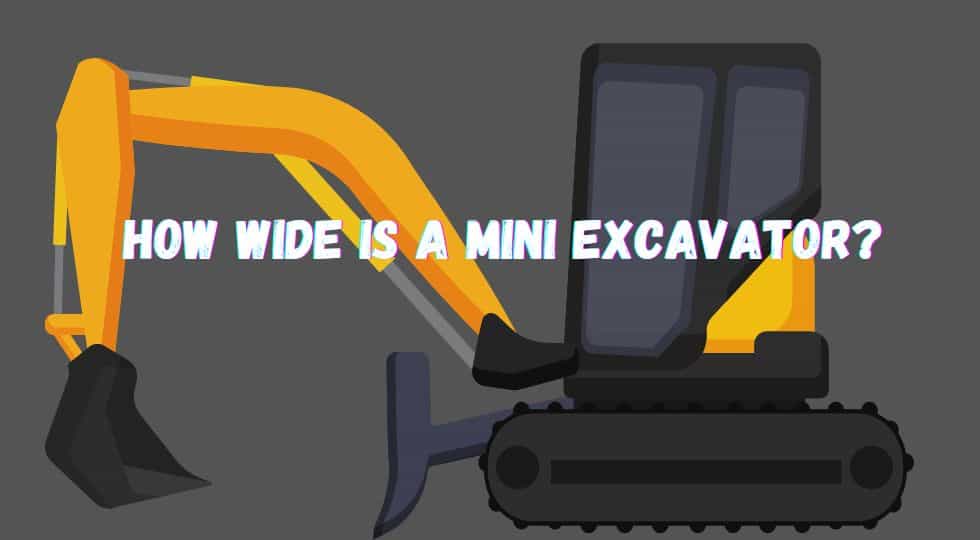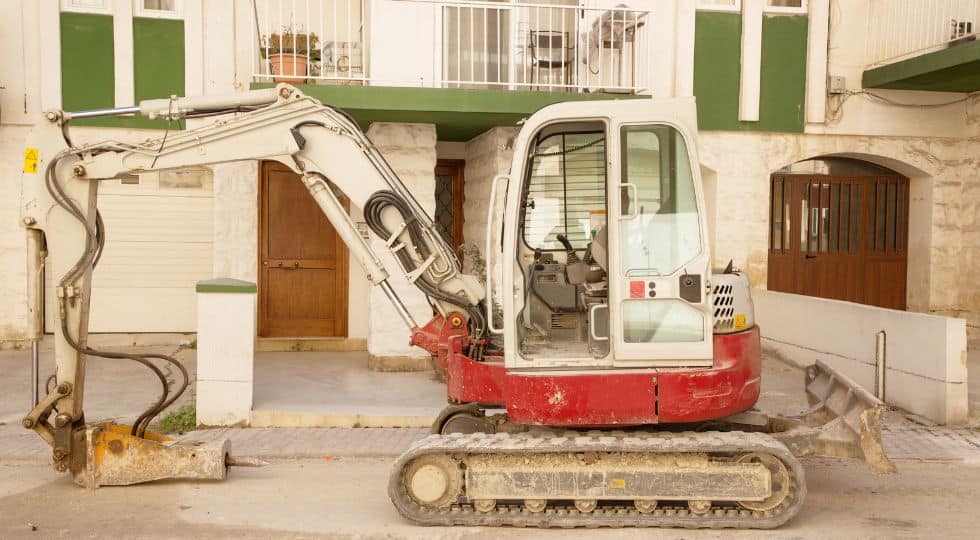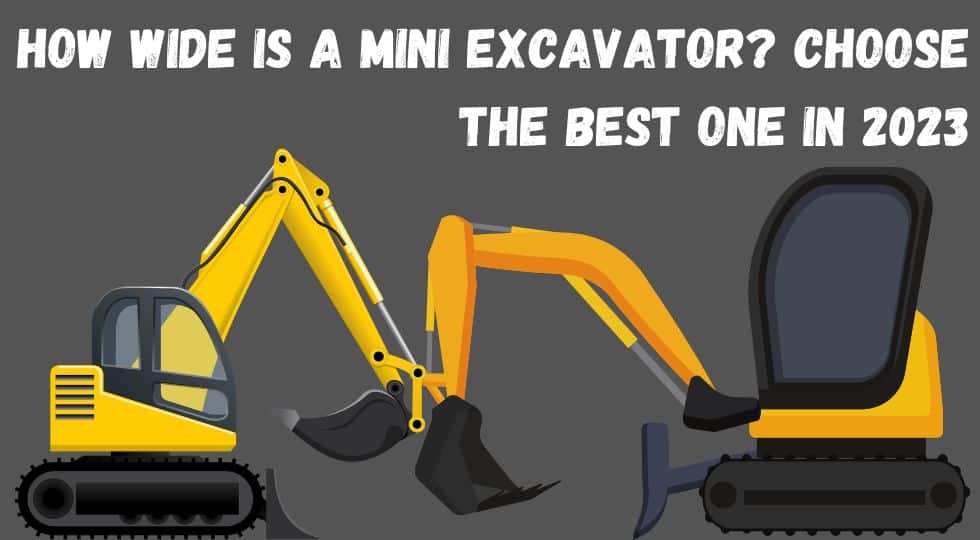How Wide is a Mini Excavator? A mini excavator is versatile equipment commonly used in construction, landscaping, and other industrial applications. It is a compact machine designed to fit into tight spaces and perform various tasks. One of the most critical factors when selecting the width of a mini excavator which determines how easily it can maneuver in tight spaces. So How Wide is a Mini Excavator? and how Does this impact its performance?
The width of a mini excavator can vary depending on the model and manufacturer. Generally, mini excavators are designed to be narrow enough to fit through standard doorways and gates, making them ideal for use in residential and commercial settings. The average width of a mini excavator ranges from 3 to 6 feet, although some models can be wider or narrower.
How Wide is a Mini Excavator?
The width of a mini excavator is determined by its tracks or wheels. The ways or wheels are attached to the body of the excavator and are responsible for providing traction and support. The size of the tracks or wheels is determined by the weight and size of the excavator and the type of terrain it will be operating on.

Mini excavators with rubber tracks are generally narrower than those with steel tracks. It is because rubber tracks are more flexible and can be designed to fit into tighter spaces. They are also less likely to damage surfaces such as pavement or concrete, making them ideal for use in urban areas.
Steel tracks, on the other hand, are more durable and provide better traction on rough terrain. They are wider than rubber tracks and can be more challenging to maneuver in tight spaces. However, they are ideal for use in rugged environments where traction and stability are critical.
The width of a mini excavator also impacts its weight and stability. A wider excavator will typically be heavier and more stable than a narrower one. It is because a wider machine has a more extensive base, which provides more stability and reduces the risk of tipping over.

The machine’s width, boom, and arm’s length also impact its performance. The size of the boom and arm determines how far the excavator can reach and how deep it can dig. Mini excavators with extended booms and arms are ideal for digging deeper holes and reaching farther distances.
The width of a mini excavator is an essential factor to consider when selecting a machine for your construction or landscaping needs. It impacts the machine’s maneuverability, stability, and weight and should be carefully considered based on the specific tasks and environments in which the device will operate.
Width of mini excavators best Narrow spaces
The significant advantage of Mini excavators is their ability to maneuver in narrow spaces where larger equipment cannot go. With their narrow width and agile design, mini excavators can easily access tight spaces and perform various tasks.

In residential and urban areas, narrow spaces can often present a challenge for construction and landscaping projects. If there can be limited space for heavy machinery when working on a backyard renovation or landscaping project. It is where mini excavators come in. With their compact design and narrow width, they can easily fit through small gates and access tight spaces, making them ideal for use in residential areas.
Mini excavators can also be used in urban areas for utility installation or road maintenance. In these environments, there can be limited space to work and maneuver. With their narrow width, mini excavators can easily access these areas and perform the necessary tasks.
Another advantage of mini excavators is their ability to work in confined spaces, as machinery may have limited space to operate when working on a basement renovation. Mini excavators can dig trenches or remove debris in these tight spaces, making them an ideal tool.
Compact radius for tiny turns
Mini excavators are known for their ability to maneuver in tight spaces, thanks in part to their compact radius. The compact radius of a mini excavator is the distance between the machine’s center and the edge of the counterweight.
Small excavators with a compact radius can make tight turns and work in confined spaces. With a smaller radius, the machine is more stable and less likely to tip over when operating in confined spaces. Small excavators with a compact radius are available with both tracks and wheels. Wheeled excavators are generally more maneuverable than those with tracks, making them ideal for use on hard surfaces such as pavement or concrete.
Mini excavators are available with both tracks and wheels, providing even greater versatility when navigating narrow spaces.
Width of Different types of mini excavator
Mini excavators are available in various widths, making them suitable for different tasks and applications. Here is a different mini excavator width chart that shows the range of widths available for multiple models:

Compact mini excavators: These are the smallest and most narrow ones available. They have a width of 3 to 4 feet and are ideal for use in tight spaces and residential areas.
Mid-sized mini excavators: These mini excavators are slightly larger than compact models and have a width of around 5 to 6 feet. They suit various tasks, including landscaping, utility installation, and road maintenance.
Large mini excavators: These are the largest and widest models available. They typically have a width of around 7 to 8 feet and are suitable for heavy-duty construction and excavation tasks.
Narrow-track mini excavators: These mini excavators are designed with narrow tracks that allow them to access tight spaces and navigate through narrow paths. They have a width of around 3 to 5 feet.
Wheeled mini excavators: These mini excavators are designed with wheels instead of tracks, which makes them more agile and maneuverable. Their width is around 5 to 6 feet.
Zero-tail swing mini excavators: These mini excavators are designed with a compact rear-end design that allows them to perform tasks in tight spaces without causing damage to surrounding structures. They have a width of around 4 to 6 feet.
Variable-width mini excavators: These mini excavators are designed with the ability to adjust their width to suit different tasks and applications. The width range of around 4 to 7 feet.
Width table of Different brands of mini excavators
Here is a table showing the different widths of mini excavators from various brands:
| Brand | Model | Width (feet) |
|---|---|---|
| Bobcat | E10 | 2.3 |
| Bobcat | E35 | 6.2 |
| Caterpillar | 300.9D | 2.6 |
| Caterpillar | 305.5E2 CR | 6.4 |
| Hitachi | ZX10U-2 | 2.6 |
| Hitachi | ZX60USB-5 | 6.2 |
| JCB | 18Z-1 | 3.3 |
| JCB | 8055ZTS | 6.3 |
| Kubota | K008-3 | 2.3 |
| Kubota | KX057-4 | 6.2 |
| Takeuchi | TB210R | 2.9 |
| Takeuchi | TB290 | 7.2 |
| Volvo | EC15E | 3.1 |
| Volvo | EC55C | 6.5 |
This table provides an overview of mini excavator widths from various popular brands. It shows that mini excavators can vary significantly in width, from as narrow as 2.3 feet to as wide as 7.2 feet. When selecting a mini excavator, it’s essential to consider the width of the machine, the task at hand, and the space available on the job site. You can contact us for further details.

